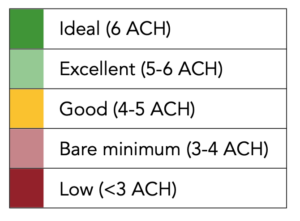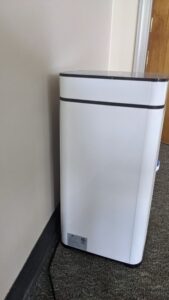Introduction
Lafayette College is utilizing the Harvard School of Public Health’s Risk Reduction Strategies for Reopening Schools report as a benchmark for evaluating our classroom air exchanges. Countless other schools and universities throughout the United States are also utilizing Harvard’s risk reduction report.
One disclaimer worth considering is that this resource– though excellent– was last updated in November 2020. The Delta variant, the strain of COVID-19 which has caused all infections on our campus this academic year thus far, wasn’t identified until December 2020. The methods for evaluating and interpreting classroom air exchanges remain largely the same, however.
ACH Benchmarks
 At the left are benchmarks for air changes per hour (or ACH), as posited by Harvard’s report. Please take note of the colors Harvard has associated with classroom ACH: green is reserved for 5-6 ACH, yellow for 4-5 ACH, and anything below 4 is in the red. It is safe to drive through an intersection when the light’s on green, you’re either rushing or not paying attention if you go through on yellow (and risking your or other’s safety, and maybe a traffic citation), and if you go through on red, you’ll almost certainly get ticketed or cause harm.
At the left are benchmarks for air changes per hour (or ACH), as posited by Harvard’s report. Please take note of the colors Harvard has associated with classroom ACH: green is reserved for 5-6 ACH, yellow for 4-5 ACH, and anything below 4 is in the red. It is safe to drive through an intersection when the light’s on green, you’re either rushing or not paying attention if you go through on yellow (and risking your or other’s safety, and maybe a traffic citation), and if you go through on red, you’ll almost certainly get ticketed or cause harm.
It is useful to consider this figure in light of that analogy: Harvard’s report isn’t endorsing a 4-5 ACH. Instead, they’re saying you might be putting yourself at risk until you reach the benchmark of a 5-6 ACH.
Another analogy might be Lafayette College’s grading scale: above 6 ACH is “excellent,” and would earn an A; 6 ACH alone is “good,” and would earn a B; 5-6 ACH is “satisfactory,” and would earn a C; and anything below 5 ACH means you probably won’t earn credit or might even fail the class.
It is absolutely critical to understand the importance of reaching, at an absolute minimum, 5 ACH. “I hear people over and over again using masking as the central focus for prevention,” said Michael Osterholm, the director of the Center for Infectious Disease Research and Policy (CIDRAP), “and we know it’s the other environmental-related reduction methods that have the most impact.” Osterholm added that “as concerned citizens, you must address your schools about ventilation. How much? Is it five to six air exchanges an hour?”
Calculating ACH
To calculate the ACH of any room on Lafayette College’s campus, please follow the below steps:
- Determine whether or not the room you wish to calculate the ACH of already has a recorded ACH. To do this, consult the Air Exchange Documents page. If the room already has a recorded ACH, just remember to add that number and the final result you get from the below steps. If the room doesn’t already have a recorded ACH, simply proceed with the below steps.
- Find the square footage of the room. To do this, measure the length and width of the room, and multiply those two numbers.
- Divide 1680 with the product you got by multiplying the length and width, so 1680/product.
- The result you get is the ACH of the room you have measured. (Remember: if the room already had a recorded ACH, add that to your result.)
I’ll walk you through an example using measurements I recorded of Pardee 320A.
- Pardee 320A doesn’t have a recorded ACH, so I can move on.
- Pardee 320A has a length of ~21.5 feet and a width of ~21.5 feet. So, if I multiply 21.5 by 21.5, I get a product of 462.25. Therefore, Pardee 320A has a square footage of about 462.25.
- 1680/462.25 = ~3.63.
- So, Pardee 320A has an ACH of about 3.63, which, as you are now familiar, is not at all acceptable. In fact, it is a failing grade!
Why Divide by 1680?
When calculating the ACH of rooms on our campus, we have to divide 1680 by the square footage of the measured room because the Medify Air MA-40 Air Purifiers the College has purchased are advertised to change the air in a 1680 square foot room once per hour.
So, if a room was exactly 1680 square feet, had no recorded ACH before the installation of the Medify portable air cleaners (PACs), and had exactly one MA-40 in it, the calculation would come out to 1680/1680, and this hypothetical room would have 1 ACH.
Another hypothetical worth considering is that if a room has no recorded ACH before the installation of the PAC, the largest a room could be to still satisfy 5 ACH is 336 square feet. That is, 1680/336 = 5. So, any room larger than 336 square feet that had no ACH before the installation of PACs and only has one PAC installed will not have sufficient ACH.
The MA-40 Air Purifiers
Three things that are important to mention when it comes to the MA-40 Air Purifiers which the College has purchased:
- The MA-40 Air Purifier can only change up to 1680 square feet an hour if the machine is running on High and if its filter has been installed correctly.
- If the MA-40 Air Purifier is not given 10 inches of space on the air intake or clean air outlet sides of the machine, its air circulation is being obstructed, and it won’t be able to run effectively. This was the case in Pardee 320A (see photo).
- Finally, I encourage both fellow students and Professors to read the instruction manual for the MA-40 Air Purifiers on our campus such that they can familiarize themselves with the machine’s settings. I also recommend that those who are interested review the product page on Medify Air’s website for the MA-40 Air Purifiers to be aware of the additional technical specifications not addressed here.
Closing Thoughts and Disclaimers
There are many other factors that can contribute to a classroom’s ACH, either positively or negatively. Either due to a lack of tools or access, I was unable to measure these factors. I do encourage those that are interested and would like to get even more accurate data than the ACH Calculations detailed above to review two more Harvard School of Public Health documents.
One is a comprehensive 46-page guide to measuring ventilation rates in classrooms, which you can access by clicking here. Another is a shorter, 8-page document that offers more detailed considerations on portable air cleaners (PACs), such as formulae for calculating Clean Air Delivery Rates (CADR) and filter efficiency, as well as more data that contextualizes the target of 5 ACH. You can access that document by clicking here.
Additional disclaimers I’d like to provide are those in regard to the Air Exchange Documents provided on a different webpage on this site. The Air Exchange Documents downloadable from that web page have been altered slightly from the form in which I received them: both to protect the anonymity of the source and also for clarity.
The documents as I received them had some data on whether or not PACs were installed in a particular classroom and, if so, how many. I’ve only ever seen one PAC in the classrooms I’ve entered, but that may not be the case for all classrooms. Some may have more; some may have none. And, of course, before you calculate the ACH of any particular room on Lafayette College’s campus, you’ll need to know if there are PACs installed and, if so, how many, so please check that for yourself if you wish to get the most accurate data possible.
As to the “Room Size” and “ACH Actual” columns included on the Air Exchange Documents, those are columns that never existed on the initial documents I received. I’ve added them for the convenience of those who’d like to calculate the ACH of classrooms themselves and, perhaps, are printing out the document (and would want to write in the new data).
The “ACH Max” column included on the Air Exchange Documents was not modified in any way by me. The data was input either by Facilities, the “outside consultant with expertise in airflow” who evaluated our classroom’s ACH, or some other official associated with the College. For the cells under “ACH Max” which don’t have a number but, instead, two dashes, reason suggests that either the ACH of those rooms were never evaluated, or the ACH of those rooms, before the installation of any PACs, was zero.
With that said, until the College either corrects this analysis or releases for public consumption more up-to-date evaluations of classroom ACHs, I stand by my claims in September 24th’s The Lafayette: it may be possible that up to 74 learning spaces (classrooms, labs, seminar rooms, etc.) on campus– or 41% of all learning spaces on campus— do not have safe air exchange levels.
